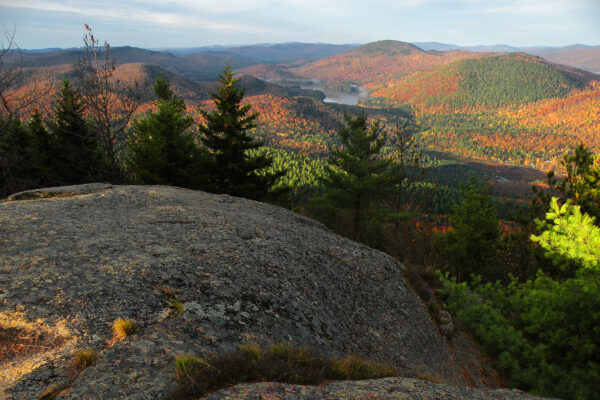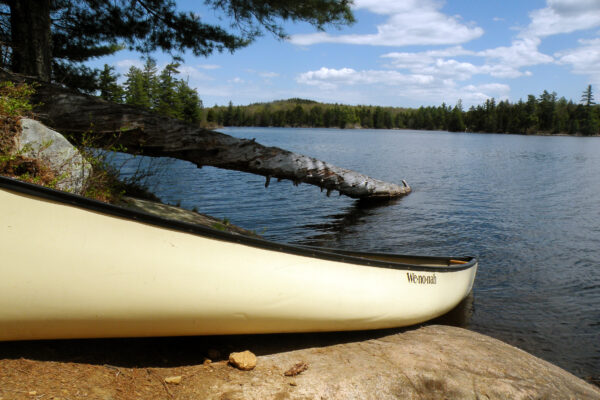Part 2 of 3
The High Peak of the Southern Adirondacks: A History of Crane Mountain
Part 1: The Lady of Crane Mountain
Part 2: The Paint Mine and the Tower
Part 3: Paul Schaefer’s Winter Ascent
Locals regarded Crane and Huckleberry mountains as places to pick berries—specifically blackberries, raspberries, and huckleberries (blueberries)—as well as a source of paint pigment and other minerals. Outsiders, however, viewed the mountain in terms of its recreational potential. Long before young Julia Oliver began guiding parties up the mountain for a quarter, Crane was a well-known hiking and camping destination. Although its northern slopes are much gentler, it seems that everyone who hiked the mountain for pleasure preferred the rugged adventure provided by the steep southwestern face. One of the earliest detailed accounts of climbing to the summit came in August 1870, when a writer for the Troy Daily Times described the experience in prose that was by turns lyrical and descriptive:
Our course lies through green meadows reaching up to the woodlands skirting the lower slopes. Into the woods we go and climb up, up, up, steeper and steeper, till the trees become sparser and we pause for breath and look back. Far below are the valleys, but the summit is far above and we toil on. The lower world recedes as we climb, and the mountain lifts us heavenward. Three hours of hard climbing and we stand upon the summit, and lo! recompense for our toil! We lie down on the soft moss which covers this wind-swept pinnacle, and while we take breath look around. A few stunted evergreens, a little low shrubbery and moss, make up the vegetation. Just below the main peak, on what appears to be the notch of the mountain as seen from a distance, but which is really a large plateau, vegetation is much more abundant. On this plain is a beautiful crystal lake of several acres in extent, with a light fringe of birches and poplars around it, and in it a small island covered with the green cones of the balsam fir.
The headwaters of Paintbed Brook, located on the back side of the mountain, were the site of Crane’s ochre deposit, which was noted as a source of mineral wealth as early as 1813 when Horatio Gates Spafford mentioned the presence of the ore in his Gazetteer of the State of New York. A Boston man named D. M. Haley took samples from the site in 1893, and tests determined that the material was pure and would be easy to refine. In its natural state “it is a beautiful gold color, and by applying certain degrees of heat the color changes to red, pink, crimson, etc.”
Haley left the Franklin Paint Company in Sandy Hill to establish The Glen Mining Company in 1894, building a camp and several drying sheds at the site. The Warrensburg News described the operation in 1895:
The deposit extends along the entire north base of Crain mountain [sic] and the operators have bored down seventy feet and found no bottom to the paint. About five acres of wood land have been cleared and a building 60×40 feet erected and equipped with the latest improved machinery for the manufacture of both dry and oil colors. Power is supplied by a New Impulse, or Hurdy Gurdy water motor, which is run by a three-quarter inch stream conveyed by iron pipe from a lake near by the summit of the mountain. There is a fall of 700 feet and the motor furnishes fifty horse power. Most of the paint is shipped in the dry powder. The oil paints are handled exclusively by Mr. Haley, who has an office at Jonsburgh Corners [sic]. He is now introducing them through Northern New York and will soon open an office in Buffalo. The paint is composed largely of aluminum combined with iron oxides. The iron being fully oxidized by the natural elements before it is mined cannot undergo further change, while the aluminum is entirely non-corrosive, which makes the paint practically indestructible when exposed to the weather on buildings. It is of the same composition and from the same vein as the paint known as “Johnsburgh Brown,” which may be seen on many buildings in Johnsburgh, where it has stood for over forty years and is yet in good condition, remaining firm and intact.

The size of the deposit was expected to be “immense,” and about a dozen people were employed at the mine. However, on the night of January 22, 1896, the adjoining two-story buildings that housed the mill and burner room were destroyed by fire, with a loss of about $5,000. The mine was insured, and the company intended to rebuild the plant—but this effort was thwarted by a second disaster that occurred a few weeks later, on March 1, 1896. The Warrensburg News reported the events:
D. M. Haley, superintendent of the Glen Paint company’s works at Johnsburgh, together with his wife and a young man employed in the works, had a narrow escape from a horrible death Sunday morning. Mr. Haley had been working at the mine for sometime clearing away the debris of the recent fire, preparatory to rebuilding a portion of the plant. He lives in a house near the mine at the foot of Crane mountain. The rain of Saturday loosened the snow on the mountain and early Sunday morning an avalanche of snow, ice and rocks came down the mountain with terrible force. Fortunately some large rocks turned a portion of it to one side and only a part of the force struck the house, in which the three persons were sleeping. But this broke in the side of one room and filled it with snow and rocks to the depth of three feet. The furniture was completely demolished and the occupants of the house were badly shaken up. It was almost like an avalanche in Switzerland. The mass reached as high as the second story windows as it swept by the house with a noise like thunder. Had the full force struck the house it would have been crushed and buried beneath tons of snow and rocks.
This combination of events apparently convinced the company to shift its primary operations away from the mountain to a more accessible location, because by 1899 the newspaper reported that The Glen Mining Company was running a graphite mine at a new “lower mill” on the mountain, presumably near Mill Creek. The forty tons of dry paint located in a storehouse at the upper works were being moved down the mountain and made into a liquid metallic roofing paint. The iron pipe that had brought water down from Crane Mountain Pond was removed, and in 1902 the 600-acre lot containing the paint mine was sold to the Raquette Falls Land Company.

The state first acquired the summit of the mountain (but notably not the pond) at a tax sale in 1885. However, the purchase was cancelled by the Adirondack Timber and Mineral Company in 1893 through an antiquated law that allowed private entities to “redeem” state lands if they could demonstrate that the tax sale had been invalid. In this case, the company asserted that the prior owner had been the Adirondack Railroad Company, which was exempt from taxation. When the original Adirondack Park boundary was adopted in 1892, it split the Mill Creek valley so that the mountains to the west were included, but Crane Mountain was not. It would not be until after the turn of the century that the state would permanently reacquire the mountain.
In 1911 the Conservation Commission placed an observation station on the summit of Crane, with a telephone line that connected it to the central office in North Creek. Rather than a tower, the station consisted of two camps: one at the pond where the observer staid at night, and one on the summit. The materials for these camps, as well as the insulated copper wire used for the four-mile-long telephone line, were carried up the mountain on the backs of men. An inspector from the federal government pronounced the Crane Mountain station to be the best in the state. Interestingly, the commission changed the name of Crane Mountain Pond to Lake Cunningham in honor of its district ranger, P. J. Cunningham.

The station overlooked a vast terrain that included portions of four counties. A writer for The Warrensburgh News opined that it would be easy for the observer to spot a fire early and report it to the rangers before it spread, giving equal protection to both public and private property in the region. However, not everyone regarded its presence favorably:
In August, 1913, some miscreant cut the telephone wire in several places and set fire to the mountain in the night time, and before the observation man could get help there the fire had burned over 200 acres, and it took seventy men several days to extinguish it. This was in the dry season when no rain had fallen in forty-one consecutive days, and everything burned that the fire got near and in some places held in the ground for a month or more. No valuable timber was burned as the fire was held on the mountain top.
The effort to fight the fire was led by Forest Ranger R. T. Armstrong, who believed “the fire was started by berry pickers.” A few years later, in 1919, a thirty-five foot steel tower was erected on the summit.
Neighboring Huckleberry Mountain was the scene of another forest fire that burned for more than two weeks in the summer of 1929. It charred a portion of the Forest Preserve as well as land owned by the McPhillips Brothers, a lumbering firm based at Friends Lake. Crews dug five miles of trenches to contain this blaze, which was eventually doused by a timely rain shower.



